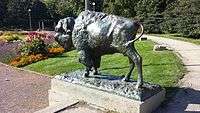Edward Kemeys
.jpg)
Edward Kemeys (January 31, 1843 – May 11, 1907) was an American sculptor[1] and considered America's first animalier.[2] He is best known for his sculptures of animals, particularly the two bronze lions that mark the entrance to the Art Institute of Chicago Building in Chicago Illinois.[3] Kemeys was also a Captain in the 4th United States Colored Heavy Artillery, Company H, writer, lecturer, and adventurer in the Western United States.[4]
Life
Kemeys was born on January 31, 1843 in Savannah, Georgia.[5] to Abby Greene of Providence, RI and William Kemeys of Scarborough, NY.[4] The Kemeys family lived in Savannah, GA, moving back to New York after the death of his mother in 1843. [4] [6] City life did not suit Kemeys and in an interview remembered " Then came the first great event in my life, my first trip to the West, to visit some relatives her in Illinois... I was only thirteen years of age, and I was plunged right into the richness of the prairies in the fifties...". [4] Kemeys first worked in the iron business of New York City at age seventeen.
Civil War
When the Civil War broke out, Kemeys enlisted. He was 19. Kemeys volunteered for the 65th Volunteer Regiment of the State of New York. "I served in the Peninsula campaign till I fell sick of fever and was discharged. I went in again later as a second lieutenant." Kemeys re-enlisted as a commissioned officer in the 4th United States Colored Heavy Artillery, Company H attaining the rank of Captain. He resigned his commission in 1866.[4]
After the Civil War
He studied in New York City and then Paris. In Paris, he was impressed by the style of Antoine-Louis Barye, although in no sense an imitator. He made a specialty of the wild animals of the American continent. His “Fight between Buffalo and Wolves” attracted much attention at the Paris salon in 1878. Among his other important works are “Panther and Deer,” and “Coyote and Raven.” A colossal head of a buffalo for the facade of the station of the Pacific railroad at St. Louis, Missouri, which was cast in bronze in New York in August, 1887, was the largest work of its kind that had been done in the United States. Another bronze statue of a panther named "Still Hunt," is permanently situated on a rock flanking the East Drive of New York City's Central Park.
Kemeys died in Washington, D.C. on May 11, 1907.[5] He and his wife, Laura Kemeys are buried in Arlington National Cemetery. Edward's grave is in Section 3,South DIV, Site: 1659. Laura's grave is located in Section SOUTH, Site: 1669. [7]
Smithsonian American Art Museum
- Hudson Bay Wolves, 1873, in Philadelphia Zoo.
 Panther and Cubs, c. 1878, Metropolitan Museum of Art.
Panther and Cubs, c. 1878, Metropolitan Museum of Art.- Prayer for Rain, c. 1899, in West Side Park, Champaign, Illinois.
 Bronze Bison Sculpture, Humboldt Park Formal Garden, Chicago.
Bronze Bison Sculpture, Humboldt Park Formal Garden, Chicago.
Notes
- ↑ "Edward Kemeys Dead". The New York Times. May 12, 1907.
- ↑ Salmon, Robin R. (1993). Brookgreen Gardens Sculpture. Brookgreen Gardens, SC. p. 10.
- ↑ http://explorechicago.org/city/en/things_see_do/attractions/park_district/lions__in_grant_park.html
- 1 2 3 4 5 Richman, Michael (1971). Fine Art Source Newletter. Panorama City, CA: John Alan Walker. p. 89.
- 1 2 Edward Kemeys Biography, National Museum of Wildlife Art, retrieved August 26, 2011.
- ↑ "Abby Brenton Greene Kemeys (1823 - 1843) - Find A Grave Memorial". www.findagrave.com. Retrieved 2016-04-24.
- ↑ "Capt Edward Kemeys ( - 1907) - Find A Grave Memorial". www.findagrave.com. Retrieved 2016-04-24.
References
 Wilson, James Grant; Fiske, John, eds. (1892). "Kemeys, Edward". Appletons' Cyclopædia of American Biography. New York: D. Appleton.
Wilson, James Grant; Fiske, John, eds. (1892). "Kemeys, Edward". Appletons' Cyclopædia of American Biography. New York: D. Appleton.
External links
| Wikimedia Commons has media related to Edward Kemeys. |
